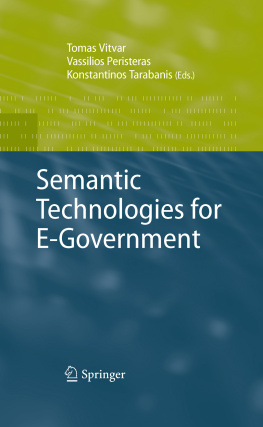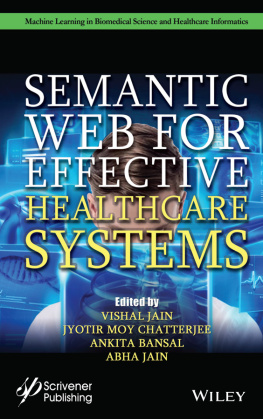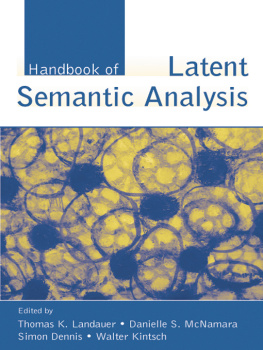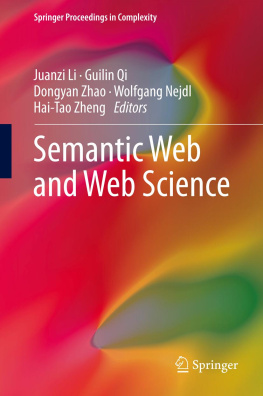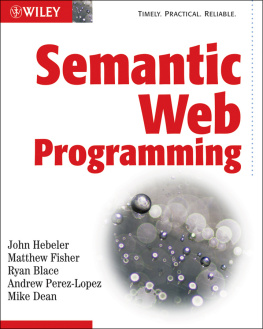Tomas Vitvar , Vassilios Peristeras and Konstantinos Tarabanis (eds.) Semantic Technologies for E-Government 10.1007/978-3-642-03507-4_1 Springer-Verlag Berlin Heidelberg 2010
Abstract
Semantics, in the context of information systems, allows for a rich description of information or behavioural models that improve application processing, integration, and performance. Research and development into semantic technologies is today centred around Semantic Web, which covers various areas of computer science including knowledge engineering, software and service engineering, data interoperability, logical languages, user experience, social networks, and last but not least, business applications. While a vast number of different semantic technologies already exist, it is not fully clear how industry may profit from them and what they bring on top of other solutions already available in the market. For this reason, many research efforts focus on showcasing semantic technologies in various domains, such as e-business, e-health, e-learning, telecommunications, transport, and e-Government.
Semantics, in the context of information systems, allows for a rich description of information or behavioural models that improve application processing, integration, and performance. Research and development into semantic technologies is today centred around Semantic Web, which covers various areas of computer science including knowledge engineering, software and service engineering, data interoperability, logical languages, user experience, social networks, and last but not least, business applications. While a vast number of different semantic technologies already exist, it is not fully clear how industry may profit from them and what they bring on top of other solutions already available in the market. For this reason, many research efforts focus on showcasing semantic technologies in various domains, such as e-business, e-health, e-learning, telecommunications, transport, and e-Government.
E-Government, like other mentioned areas, is facing several problems in systems and information integration, information extraction, and information representation across heterogeneous organizations. In particular, e-Government faces big challenges to achieve interoperability and integration, taking into account differences in laws, regulations, services, administrative processes, and different languages across regions and countries. Such differences are related to a great variety of computer-based solutions used at various levels and create the requirement for technical, content, and process integration. On the other hand, semantic technologies have been of interest to the research community for the last 78 years, and as any other research domain, they require a large, dynamic, heterogeneous, and shared information space to be effectively tested and evaluated. Therefore, the combination of these two areas is very much natural. E-Government provides an ideal test-bed for semantic technologies research and, on the other hand, semantic technologies provide an ideal platform for the vision of a knowledge-based, citizen-centric, and citizen-empowering, distributed and integrated e-Government. In addition, e-Government has some specific features as opposed to traditional e-business scenarios, which are of interest to semantic technologies research and on which semantic technologies could be properly demonstrated. From these reasons, the interest in using semantic technologies applied and customized for e-Government was naturally triggered by the research and academic community. However, e-Government empowered by semantic technologies has also recently reached developers and various public administration agencies. In the last 23 years, we witnessed the first applications of semantic technologies in real, operational e-Government systems that address these challenges, such as in the UK
In this book, we present the latest results from the EU-funded e-Government projects supported by the 6th Framework Program. The major goal of these projects was to use semantic technologies in order to improve or even revolutionize the use of ICT in public administration systems. The projects have demonstrated the added value of semantic technologies in e-Government, provided a valuable environment with particular domain-specific difficulties and shortcomings that have to be handled in semantic technologies development, verified various approaches in semantic technologies development as the most suitable for e-Government, and revealed new challenges for further research. In this introductory chapter, we will summarize all these issues; we present their basic underlying concepts and technologies and we provide a summary of the books chapters and their relations.
E-Government: A Suitable Application Domain for Semantic Technologies
This book gives an overview of how semantic technologies have been applied in different e-Government projects. The projects have used a wide spectrum of semantic technologies, including formal domain models expressed as content ontologies, formal service models expressed as service ontologies, semantic enhancements of business process models, semantic Service Oriented Architectures (SOAs) based on Semantic Web Services (SWS) frameworks, and ontology-based knowledge management.
Applying such technologies in the e-Government domain has proven to be challenging mainly for the following reasons:
Public administration (PA) is a huge, diverged, and distributed environment layered in clearly defined organizational levels (e.g., local, regional, state, and national). Additionally, currently, there are severe malfunctioning problems causing a lot of distress, embarrassment, and waste of valuable resources; thus, a great potential for improvement exists. These characteristics make the PA domain suitable and a challenging candidate for testing and applying semantic technologies and solutions on a large scale.
Public administration is hierarchically organized, which means that there is a rather clear line of command, central coordination and rigidly defined corpus of rules (e.g., laws) that explicitly define systems behaviour. These characteristics describe a domain which is relatively easy to be standardized when compared with the totally decentralized and competitive environment in the private sector.
Governments, not businesses, remain the major information processing entities in the world. The need to combine vast amount of real-time and archived data in critical domains gives a unique test-bed for testing semantic technologies. Moreover, public administration is currently considered the heaviest service industry, with a service production distributed in hundreds (even thousands) of partially independent agencies, which means that architectural paradigms like SOA and technologies adding semantics to the core service notion are particularly suitable and fit well with these structural characteristics of the domain.
In this distributed environment there is an increasing need for collaboration and interoperation among different agencies and actors. Currently, each agency acts as an isolated legacy system and thus effective communication with other legacy systems (agencies) becomes very difficult. Semantic interoperability is perceived as a key aspect to be adequately addressed in this environment, in order to make feasible direct interoperation and communication between public administration entities.
Through the implementation of EU policies, there is an increasing need for collaboration and interoperation among the Member States Administrations (MSA). Each separate national Public Administration system can be perceived as a separate legacy system with complexity and severe malfunctioning problems in its interior and less capable of effective communication with other legacy systems (other MSAs). Semantic interoperability is of great importance for communication between MSAs and could be considered as an infrastructure for further development of broader EU policies.

